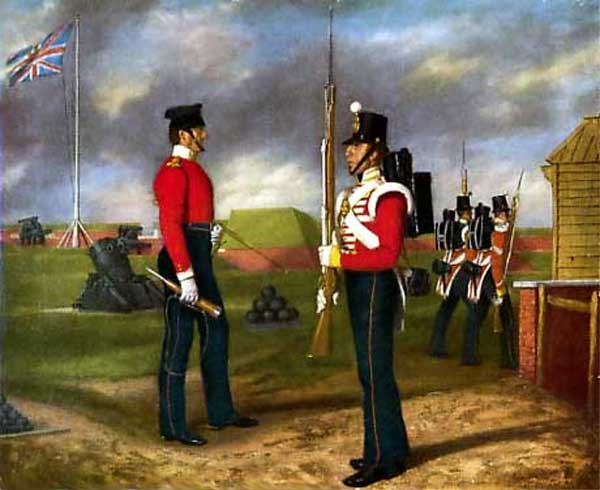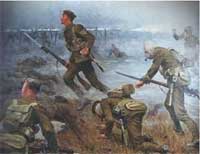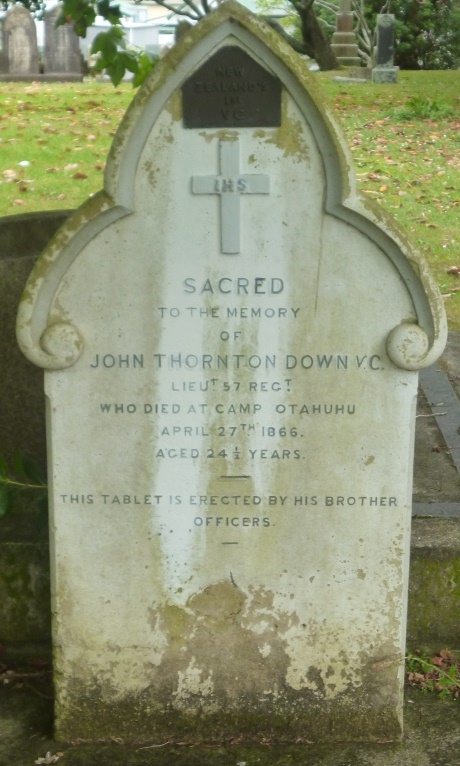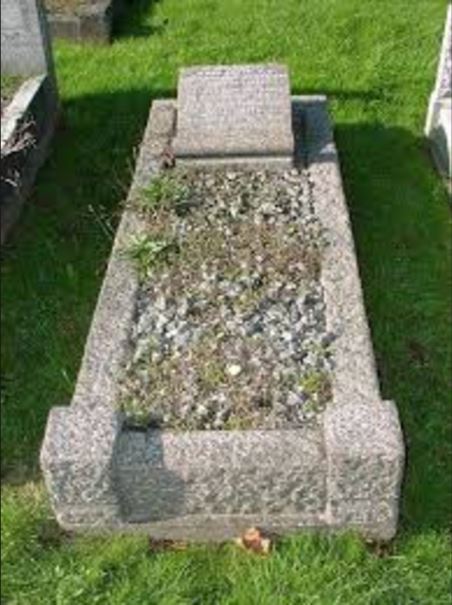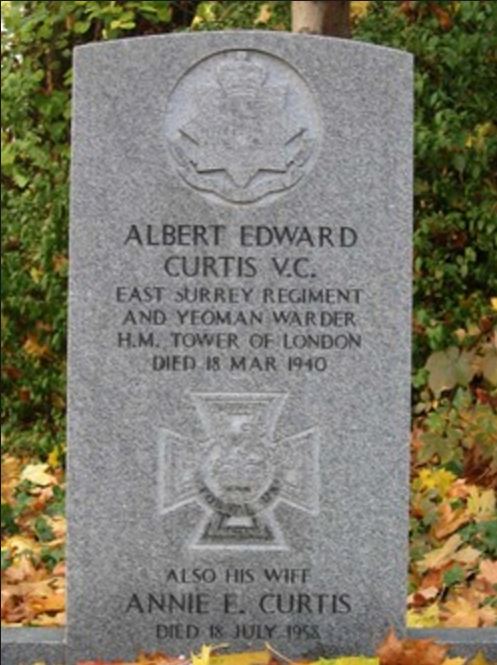
The Queen's Regiment
Victoria Cross Awards Queen's Forebear Regiments
The Victoria Cross was instituted in 1856, as a direct result of the Crimean War. It is the highest award for gallantry that a British and Commonwealth serviceman can achieve.
The following were awarded the Victoria Cross while serving with one of our Forebear Regiments:
 Sergeant John Park VC - 77th, Inkerman, 1854
Sergeant John Park VC - 77th, Inkerman, 1854
Born: February 1835, Londonderry. Died:16 May 1863 in India, from sunstroke
Awarded the Victoria Cross for many acts of bravery and devotion in the Crimean War.
He was noticed for his conduct at the battles of Alma and Inkerman; highly distinguished himself on April 19th 1855 at the taking of the Russian rifle pits, earning special praise from Colonel Egerton at the time. Severely wounded, and remarked for his determined resolution at the two attacks on the Redan.
VC held by Newarke Houses Museum, Leicester
 Private Alexander Wright VC - 77th, Crimea, 1855
Private Alexander Wright VC - 77th, Crimea, 1855
Born: 4 April 1835 in Ballemena Co. Antrim. Died 28 July 1858 aged 38
Decorated for special bravery during the whole Crimean War.
Greatly distinguished himself on the night of March 22nd 1855, in repelling a sortie and at the taking of the rifle pits on the night of April 19th 1855, being specially noticed on that occasion for the fine example he gave the men while holding the position under a terrible fire. Displayed great bravery also on August 30th 1855, when he was wounded.
Victoria Cross held by Princess of Wales Royal Regiment
 Colour Sergeant George Gardiner VC DCM - 57th, Sevastopol, 1855
Colour Sergeant George Gardiner VC DCM - 57th, Sevastopol, 1855
Born: 1821, Callwalen Co. Down. Died 17 November 1891 aged 70
On 22nd March 1855, he rallied the troops who had recently lost some trenches to the enemy, thus regaining their positions. On 18th June 1855 doing similar work at the Redan and steadying his men and fighting until the ammunition ran out.
Victoria Cross held by Princess of Wales Royal Regiment
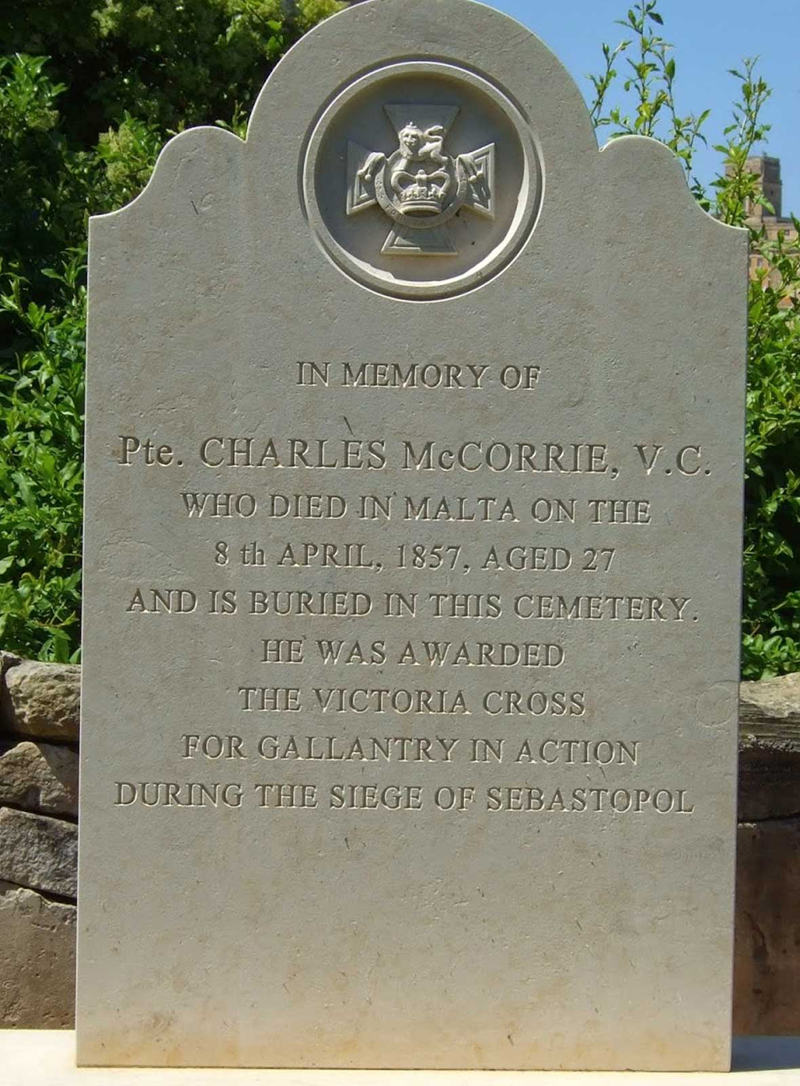 Private Charles McCorrie VC - 57th, Sevastopol, 28th June 1855
Private Charles McCorrie VC - 57th, Sevastopol, 28th June 1855
Born: 1830 Killeard Co. Antrim. Died: 8 April 1857 aged 27
On the night of 23rd June 1855, an enemy shell was launched and landed in the trench.
With no regard for himself, he threw the live shell over the parapet, thus saving many lives.
Place Of Death - Malta New headstone erected 2012
 Sergeant John Coleman VC - 97th, Sevastopol, 1855
Sergeant John Coleman VC - 97th, Sevastopol, 1855
Born: 12 July 1798, Romney Marsh, Kent. Died 21 May 1858 aged 59
On August 30th 1855 the enemy made an attack on a new sap, driving the working party in. Coleman remained in the open, fully exposed to the enemy’s rifle fire, until all around him had been killed or wounded, finally carrying one of his officers who had been injured.
Killed in action during the Indian Mutiny.
VC Held By The Queen's Own Royal West Kent Regiment Museum, Maidstone, Kent
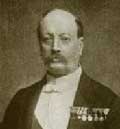 Lt Colonel Sir Frederick Francis Maude VC - Buffs, Redan, 1855
Lt Colonel Sir Frederick Francis Maude VC - Buffs, Redan, 1855
Born: 20 Dec. 1821, Lisnadill Co. Omagh Died: 20 June 1897 aged 75
When in command of the covering party of the 2nd division, Major Maude, with only nine or ten of his men, the rest having fallen and he himself being severely wounded, dashed for a traverse, which he held, and only retired when all hope of support was at an end.
Replica VC currently held at the National Army Museum, Chelsea, London
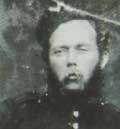 Private John Connors VC - 3rd Buffs, Redan, 1855
Private John Connors VC - 3rd Buffs, Redan, 1855
Born: Oct.1830, Listowell, Co. Kerry. Died: 29 Jan. 1857 aged 26
On September 8th 1855, during the assault on the Redan, Connors displayed great courage in personal conflict with the Russians. He also rescued an officer of the 30th Regiment who was surrounded by the enemy, one of whom he shot, and bayoneted another, and was noticed in personal combat for some time with the enemy.
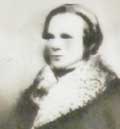 Captain Charles Henry Lumley VC - 97th, Redan, 1855
Captain Charles Henry Lumley VC - 97th, Redan, 1855
Born: 1824, Forres, Scotland. Died: 17 October 1858 aged 34
On September 8th 1855 at the assault on the Redan, Major Lumley at once attacked three Russian gunners who were reloading a field-piece, shot two of them with his revolver, then was stunned by a large stone. Recovering quickly he drew his sword and cheered on his men, when he was hit by a bullet in the mouth and severely wounded.
VC Held By The Queen's Own Royal West Kent Regiment Museum, Maidstone, Kent
 Ensign John Thornton Down VC DCM - 57th, New Zealand 1863
Ensign John Thornton Down VC DCM - 57th, New Zealand 1863
Born: 2 March 1842, Fulham. Died: 27 April 1866 aged 24
At Pontoko, New Zealand on October 2nd 1863, a soldier fell wounded within fifty yards of the bush, which was swarming with natives. At their Colonel’s call for volunteers to bring the man into shelter, Ensign Down & Drummer Stagpoole promptly responded, succeeding in carrying in the wounded man, though heavy fire was directed on them.
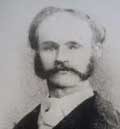 Drummer Dudley Stagpoole VC DCM -57th, New Zealand 1863
Drummer Dudley Stagpoole VC DCM -57th, New Zealand 1863
Born: 1838, Kalunan Co. Galway. Died: 1 August 1911 aged 73
(As above.) The Medal for Distinguished Conduct in the Field has already been conferred on Drummer Stagpoole, for the energy and devotion which he displayed on the 25th September, 1863, at the affair near Kaipakopako
VC held by The Queen's Royal Surrey Regiment Museum, Guildford, Surrey, England
 Corporal James Smith VC - Buffs, North West Frontier, 1897
Corporal James Smith VC - Buffs, North West Frontier, 1897
Born: 7 April 1892 Maidstone Kent. Died: 4 March 1974 age 81
On the night of September 16th 1897, Lieutenant Watson called for volunteers to enter the burning village of Bilot (NorthWest Frontier of India) and drive the enemy out with the bayonet. Corporal Smith followed his officer, and was particularly noticeable for his gallant conduct on that occasion. Later, although wounded, he continued firing and assisted in removing the wounded to a place prepared for their reception. The officer afterwards left to obtain assistance for the wounded, leaving Corporal Smith in charge of the men; and during his absence Smith directed the fire of his party, exposing himself freely in order to watch the enemy, who were unable to take the position, which was held most gallantly.
VC held by The National Army Museum, Chelsea, London
 Private Albert Edward Curtis VC - 2nd East Surrey's, South Africa, 1900
Private Albert Edward Curtis VC - 2nd East Surrey's, South Africa, 1900
Born: 6 Jan. 1866, Guildford Surrey. Died: 18 March 1940 aged 76
At Onderbank Spruit, on February 23rd 1900, Colonel RHWH. Harris was severely wounded, and lay during the whole day in an exposed position and under a heavy fire from the Boer posted behind a breastwork at short range. They fired at any one who gave any signal of life, and Colonel Harris was hit eight or nine times. Curtis made several ineffectual attempts to reach the wounded officer, and at last succeeded in doing so. Notwithstanding the fire directed upon him, Curtis attended to the Colonel’s wounds, gave him a drink from his flask and endeavoured to carry him to shelter. Finding he was not equal to the task, he called for help, upon which Private Morton immediately dashed out, and in spite of the Colonel’s entreaties to them to leave him and not risk their lives, the two men succeeded in carrying him to cover.
The Duke of York the Victoria Cross to him at Pietermaritzburg on August 14th 1901.
Victoria Cross held by The Lord Ashcroft Collection I.W.M.
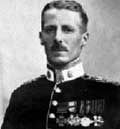 Lieutenant George Rowland Patrick Roupell VC - Hill 60, 1915
Lieutenant George Rowland Patrick Roupell VC - Hill 60, 1915
Born: 7 April 1892 Tipperary. Died: 4 March 1974 aged 81
On April 20th 1915, when he was commanding a company of his battalion if a front trench on Hill 60 which was subjected to a most severe bombardment throughout the day. though wounded in several places, he remained at his post and led his company in repelling a strong German assault.
Toward evening, his company being dangerously weakened, he went back to his battalion headquarters, represented the situation to his Commanding Officer and brought up reinforcements, passing backwards and forwards over ground under heavy fire. He held his position throughout the night and until his battalion was relieved next morning.
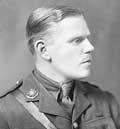 2nd Lieutenant Benjamin Handley Geary VC - Hill 60, 1915
2nd Lieutenant Benjamin Handley Geary VC - Hill 60, 1915
Born: 29 June 1891, Marylebone, London. Died: 26 May 1976 aged 84
On 20 and 21 April 1915 on Hill 60 near Ypres, Belgium, Second Lieutenant Geary led his men across exposed open ground swept by fierce enemy fire to join survivors of the Bedfordshire Regiment in a crater at the top of the hill, which he held against artillery and bomb attacks during the evening and night. Each attack was repulsed mainly owing to the fine example and personal gallantry of Second Lieutenant Geary. He deliberately exposed himself to enemy fire in order to see by the light of flares the whereabouts of the enemy. He was severely wounded early on 21 April.
Victoria Cross held by Canadian War Museum, Ottawa, Canada
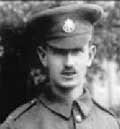 Private Edward Dwyer, East Surreys VC - Hill 60, 1915
Private Edward Dwyer, East Surreys VC - Hill 60, 1915
Born:25 November 1895, Fulham. Died: 3 September 1916 aged 20
For most conspicuous bravery and devotion to duty at "Hill 60" on the 20th April, 1915. When his trench was heavily attacked by German grenade throwers he climbed on to the parapet, and, although subjected to a hail of bombs at close quarters, succeeded in dispersing the enemy by the effective use of his hand grenades. Private Dwyer displayed great gallantry earlier on this day in leaving his trench, under heavy shell fire, to bandage his wounded comrades.
VC held by The Queen's Royal Surrey Regiment Museum, Guildford, Surrey
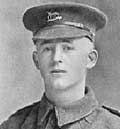 Lance Corporal Leonard James Keyworth VC - The Queen's, Givenchy, 1915
Lance Corporal Leonard James Keyworth VC - The Queen's, Givenchy, 1915
Born: 12 April 1893, Lincoln, Lincolnshire. Died: 19 October 1915 aged 22
For most conspicuous bravery at Givenchy on the night of 25-26th May, 1915. After the assault on the German position by the 24th Battalion, London Regt, efforts were made by that Unit to follow up their success by a bomb attack, during the progress of which 58 men out of a total 75 became casualties. During this very fierce encounter Lance-Cpl Keyworth stood fully exposed for 2 hours on the top of the enemy's parapet, and threw about 150 bombs amongst the Germans, who were only a few yards away.
VC held by The Queen's Royal Surrey Regiment Museum, Guildford, Surrey
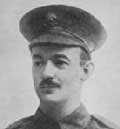 2nd Lieutenant Rupert Price Hallowes VC MC - Middlesex, Loos, 1915
2nd Lieutenant Rupert Price Hallowes VC MC - Middlesex, Loos, 1915
Born: 5 May 1881, Redhill Surrey. Died1 October 1915 aged 34
For most conspicuous bravery and devotion to duty during the fighting at Hooge between 25th September and 1st October, 1915. Second Lieutenant Hallowes displayed throughout these days the greatest bravery and untiring energy, and set a magnificent example to his men during four heavy and prolonged bombardments. On more than one occasion he climbed up on the parapet, utterly regardless of danger, in order to put fresh heart into his men. He made daring reconnaissances of the German positions in our lines. When the supply of bombs was running short he went back under very heavy shell fire and brought up a fresh supply. Even after he was mortally wounded he continued to cheer those around him and to inspire them with fresh courage.
VC held by The National Army Museum, Chelsea, London
 Sergeant Harry Wells VC - Royal Sussex, Loos, 1915
Sergeant Harry Wells VC - Royal Sussex, Loos, 1915
Born: 19 Sept. 1888, Millbank Kent. Died: 25 Sept. 1915 aged 27
On 25 September 1915 near Le Rutoire, Loos, France, when the platoon officer had been killed, Sergeant Wells took command and led his men forward to within 15 yards of the German wire. Nearly half the platoon were killed or wounded and the remainder were much shaken but Sergeant Wells rallied them and led them on. Finally, when very few were left, he stood up and urged them forward once again and while doing this he was killed.
VC held by The Royal Sussex Regiment Museum, Eastbourne, East Sussex
 2nd Lieutenant Arthur James Terence Fleming-Sandes VC - East Surrey's, Loos, 1915
2nd Lieutenant Arthur James Terence Fleming-Sandes VC - East Surrey's, Loos, 1915
Born:24 June 1894, London. Died: 24 May 1961 aged 66
On 29 September 1915 at the Hohenzollern Redoubt, France, Second Lieutenant Fleming-Sandes was sent to command a company which was in a very critical position. His men, very much shaken by continual bombing and machine-gun fire, were beginning to retire, but the second lieutenant collected a few bombs and jumping on the parapet in full view of the Germans, only 20 yards away, threw them. Although severely wounded almost at once, he continued to advance and throw bombs until he was again wounded. This act put new heart into his men and saved the situation.
VC held by The Queen's Royal Surrey Regiment Museum, Guildford, Surrey
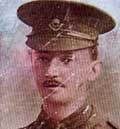 Lieutenant Eric Archibald McNair VC - Royal Sussex, Hooge, 1916
Lieutenant Eric Archibald McNair VC - Royal Sussex, Hooge, 1916
Born: 16 June 1894, Calcutta, British India. Died: 12 August 1918 aged 24
On 14 February 1916 near Hooge, Belgium, when the enemy exploded a mine, Lieutenant McNair and a number of men were flung into the air and many were buried. Although much shaken, the lieutenant at once organised a party with a machine-gun to man the near edge of the crater and opened rapid fire on the enemy who were advancing. They were driven back with many dead. Lieutenant McNair then ran back for reinforcements, but the communication trench being blocked he went across the open under heavy fire and held up the reinforcements the same way.
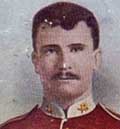 Corporal William Richard Cotter VC - Buffs, Hohenzollern, 1916
Corporal William Richard Cotter VC - Buffs, Hohenzollern, 1916
Born: 1882, Folkestone. Died: 1916 aged 34
Despite having lost an eye after being glassed in an ale house in Dover, Cotter returned to the front in 1916. When his right leg had been blown off at the knee and he had also been wounded in both arms, he made his way unaided for fifty yards to a crater, steadied the men who were holding it, controlled their fire, issued orders, and altered the dispositions of his men to meet a fresh counter-attack by the enemy. For two hours he held his position, and only allowed his wounds to be roughly dressed when the attack had quieted down. He could not be moved back for fourteen hours, and during all this time had a cheery word for all who passed him. There is no doubt that his magnificent courage helped greatly to save a critical situation.
 CSM Nelson Victor Carter VC - Royal Sussex, Somme, 1916
CSM Nelson Victor Carter VC - Royal Sussex, Somme, 1916
Born: 9 April 1887, Eastbourne, Sussex. Died: 30 June 1916 aged 29
During an attack he was in command of the fourth wave of the assault. Under intense shell and machine gun fire he penetrated, with a few men, into the enemy's second line and inflicted heavy casualties with bombs. When forced to retire to the enemy's first line, he captured a machine gun and shot the gunner with his revolver. Finally, after carrying several wounded men into safety, he was himself mortally wounded and died in a few minutes. His conduct throughout the day was magnificent
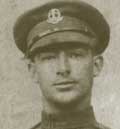 Private Robert Ryder VC - Middlesex, Thiepval, 1916
Private Robert Ryder VC - Middlesex, Thiepval, 1916
Born: 17 December 1895, Harefield, Middlesex. Died: 1 December 1978 aged 83
On September 26, 1916, in Thiepval, France, his company was under heavy rifle fire and all his officers had become casualties.
Without thinking for his own safety, Private Ryder ran alone towards the enemy trench, which he managed to clear using his Lewis gun
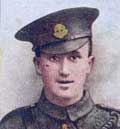 Private Frederick Jeremiah Edwards VC - Middlesex, Thiepval, 1916
Private Frederick Jeremiah Edwards VC - Middlesex, Thiepval, 1916
Born: 3 October 1894, Queenstown, Co. Cork. Died: 9 March 1964 aged 69
On 26 September 1916 at Thiepval, France. Part of the line was held up by machine-gun fire and all the officers had become casualties. Private Edwards, grasping the situation and on his own initiative, dashed out towards the gun, which he knocked out with his bombs. This very gallant act, coupled with great presence of mind and disregard of personal danger, made further advance possible and cleared up a dangerous situation.
 Sergeant Henry Cator VC MM - East Surreys, Arras, 1917
Sergeant Henry Cator VC MM - East Surreys, Arras, 1917
Born: 24 January 1894, Drayton, Norwich. Died: 7th April 1966 aged 72
Whilst consolidating the first line captured system his platoon suffered severe casualties from hostile machine-gun and rifle fire. In full view of the enemy and under heavy fire Sergeant Cator, with one man, advanced to cross the open to attack the hostile machine gun. The man accompanying him was killed after going a short distance, but Sergeant Cator continued on and picking up a Lewis gun and some drums on his way succeeded in reaching the northern end of the hostile trench. Meanwhile, one of our bombing parties was seen to be held up by a machine gun. Sergeant Cator took up a position from which he sighted this gun and killed the entire team and the officer whose papers he brought in. He continued to hold that end of the trench with the Lewis gun and with such effect that the bombing squad was enabled to work along, the result being that one hundred prisoners and five machine guns were captured.
VC held by The Lord Ashcroft Collection, I.W.M.
 Corporal Edward "Tiny" Foster VC, East Surreys, Villers-Plouich, 1917
Corporal Edward "Tiny" Foster VC, East Surreys, Villers-Plouich, 1917
Born: 4 January 1886 Streatham, London. Died: 22 January 1946 aged 60
On 24 April 1917 at Villers-Plouich, Nord, France, during an attack, the advance was held up in a portion of the village by two machine-guns which were entrenched and strongly covered by wire entanglements. Corporal Foster who was in charge of two Lewis guns succeeded in entering the trench and engaged the enemy guns. One of the Lewis guns was lost, but the corporal rushed forward, bombed the enemy and recovered the gun. Then, getting his two guns into action, he killed the enemy gun team and captured their guns.
VC held by The Lord Ashcroft Collection, I.W.M.
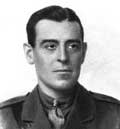 Lieutenant Colonel Arthur Drummond Borton VC CMG DSO - The Queen's, Gaza, 1917
Lieutenant Colonel Arthur Drummond Borton VC CMG DSO - The Queen's, Gaza, 1917
Born:1 July 1883, Cheveney, Kent. Died: 5 January 1933 age 49. Buried at Hunton, Kent
On 7 November 1917 at Palestine, Borton deployed his battalion for attack and at dawn led his companies against a strongly held position. When the leading waves were checked by withering fire, he moved freely up and down the line under heavy fire and then led his men forward, capturing the position. At a later stage he led a party of volunteers against a battery of field-guns in action at point-blank range, capturing the guns and the detachments. His fearless leadership was an example to the whole brigade.
VC held by The Queen's Royal Surrey Regiment Museum, Guildford, Surrey
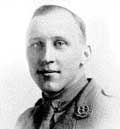 Captain Allastair Malcolm Cluny McReady-Diarmid VC - Middlesex, Mouvres, 1917
Captain Allastair Malcolm Cluny McReady-Diarmid VC - Middlesex, Mouvres, 1917
Born: 21 March 1888, Southgate, London. Died: 1 December 1917 aged 29
On 30 November/1 December 1917 at the Moeuvres Sector, France, when the enemy penetrated into our position, and the situation was extremely critical, Captain McReady-Diarmid led his company through a heavy barrage and immediately engaged the enemy and drove them back at least 300 yards, causing numerous casualties and taking 27 prisoners. The following day the enemy again attacked and drove back another company which had lost all its officers. The captain called for volunteers, and leading the attack, again drove them back. It was entirely due to his throwing of bombs that the ground was regained, but he was eventually killed by a bomb.
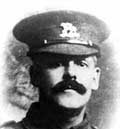 Lance Corporal John William Sayer VC - 8th (Royal) West Surrey's, Le Verguier, 1918
Lance Corporal John William Sayer VC - 8th (Royal) West Surrey's, Le Verguier, 1918
Born: 12 April 1879, Ilford, Essex. Died: 18 April 1918 aged 39
On 21 March 1918 at Le Verguier, France, Lance Corporal Sayer held the flank of a small isolated post for two hours. Owing to mist the enemy approached from both sides to within 30 yards before being discovered, but the lance corporal, on his own initiative without assistance, beat off a succession of attacks, inflicting heavy losses. During the whole time he was exposed to heavy fire but his contempt of danger and skill in the use of his fire-arms enabled the post to hold out until nearly all the garrison had been killed and he himself wounded and captured. He died as a result of wounds four weeks later.
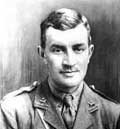 Lieutenant Colonel Christopher Bushell VC - DSO, 7th (Royal) West Surrey's, St Quentin, 1918
Lieutenant Colonel Christopher Bushell VC - DSO, 7th (Royal) West Surrey's, St Quentin, 1918
Born: 31 October 1888, Neston, Cheshire. Died: 8 August 1918 aged 30
Lieut-Colonel Bushell personally led ‘C’ Company of his battalion, who were cooperating with an Allied Regiment in a counter-attack, in face of very heavy machine-gun fire. In the course of this attack he was severely wounded in the head, but he continued to carry on, walking in front of both English and Allied troops, encouraging and re-organising them. He refused even to have his wound attended to until he had placed the whole line in a sound position and formed a defensive flank to meet a turning movement by the enemy. He then went to Brigade Headquarters and reported the situation, had his wound dressed and returned to the firing line, which had come back a short distance. He visited every portion of the line, both English and Allied, in face of terrific machine-gun and rifle fire, exhorting the troops to remain where they were and to kill the enemy. In spite of the wounds, this gallant officer refused to go to the rear, and eventually had to be removed to the dressing station in a fainting condition.
To the magnificent example of energy, devotion and courage shown by their Commanding Officer is attributed the fine spirit displayed and the keen fight put up by his battalion, not only on the day in question, but on each succeeding day of the withdrawal.
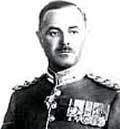 Captain Alfred Maurice Toye VC MC - Middlesex, Eterpigny, 1918
Captain Alfred Maurice Toye VC MC - Middlesex, Eterpigny, 1918
Born: 15 April 1897, Aldershot, Hampshire. Died: 6 September 1955 aged 58
On 25 March 1918 at Eterpigny Ridge, France, Captain Toye displayed conspicuous bravery and fine leadership. He three times re-established a post which had been captured by the enemy and, when his three other posts were cut off, he fought his way through the enemy with one officer and six men. He counter-attacked with 70 men and took up a line which he maintained until reinforcements arrived. In two subsequent operations he covered the retirement of his battalion and later re-established a line that had been abandoned before his arrival. He was twice wounded but remained on duty.
 Sergeant Thomas James Harris VC MM - The Queen's Own Royal West Kent's, Amiens, 1918
Sergeant Thomas James Harris VC MM - The Queen's Own Royal West Kent's, Amiens, 1918
Born: 30 January 1892, Snodland, Kent. Died: 9 August 1918
On two successive occasions, he attacked single-handed two enemy machine guns which were causing heavy casualties and holding up the advance. He captured the first gun and killed the crew, but was himself killed when attacking the second one. It was largely due the great courage and initiative of this of this gallant N.C.O. that the advance of the battalion was continued without delay and undue casualties. Throughout the operation he showed a total disregard for his own personal safety, and set a magnificent example to all ranks.
 Private Jack Harvey VC - Queen's, Boucheavesnes, 1918
Private Jack Harvey VC - Queen's, Boucheavesnes, 1918
Born 24th August 1891, Peckham, London. Died: 15 August 1940 aged 48
When the advance of his company was held up by intense machine-gun fire, Private Harvey at once dashed forward through heavy enemy fire and rushed a machine-gun post, shooting two of them and bayoneting another. He then destroyed the gun and continued to work his way along the enemy trench and, single handed, rushed an enemy dug-out which contained thirty-seven of the enemy and compelled them to surrender. By these two acts of great gallantry he saved his company heavy casualties and enabled the whole of the attacking line to advance. Throughout the entire operation he showed the most magnificent courage and determination and, by the splendid example which he set to all ranks, materially assisted in the success of the operation
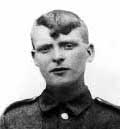 Corporal John McNamara VC - East Surreys, Lens, 1918
Corporal John McNamara VC - East Surreys, Lens, 1918
Born: 28 October 1887, Walton-Le-Dale, Lancashire. Died: 16 October 1918 aged 30
On 3 September 1918 north west of Lens, France, when operating a telephone in evacuated enemy trenches occupied by his battalion, Corporal McNamara realised that a determined enemy counter-attack was gaining ground. Rushing to the nearest post, he made very good use of a revolver taken from a wounded officer and then, seizing a Lewis gun, he fired it until it jammed. By this time, he was alone in the post and, having destroyed the telephone, he joined the nearest post and maintained a Lewis gun until reinforcements arrived.
VC held by The Queen's Royal Surrey Regiment Museum, Guildford, Surrey, England
 2nd Lieutenant Donald John Dean VC - The Queen's Own Royal West Kent's, Lens, 1918
2nd Lieutenant Donald John Dean VC - The Queen's Own Royal West Kent's, Lens, 1918
Born: 19 April 1897, Herne Hill, London. Died: 9 December 1985 aged 88
During the period 24 September–26 September 1918, north-west of Lens, France, Lieutenant Dean with his platoon held an advance post established in a newly captured enemy trench. The post was ill-prepared for defence and lieutenant worked unceasingly with his men consolidating the position, under very heavy fire. Five times in all the post was attacked and on each occasion the attack was repulsed. Throughout the whole of this time Lieutenant Dean inspired his command with his own contempt of danger and set the highest example of valour, leadership and devotion to duty.
 Lieutenant Colonel Dudley Graham Johnson VC DSO MC - Royal Sussex Sambre, 1918
Lieutenant Colonel Dudley Graham Johnson VC DSO MC - Royal Sussex Sambre, 1918
Born: 13 Feb. 1884, Bourton-on-the-Water, Gloucestershire Died: 21 Dec. 1975 aged 91
On 4 November 1918 at Sambre Canal, France, the 2nd Infantry Brigade, of which the 2nd Battalion, The Royal Sussex Regiment formed part, was ordered to cross by the lock south of Catillon. The position was strong and the assaulting and bridging parties were halted on arrival at the waterway 100 yards from the canal by a heavy barrage. At this point Lieutenant-Colonel Johnson arrived and personally led an assault but heavy fire again broke up the attack. He reorganized the assaulting and bridging parties and this time effected a crossing but the success of this dangerous operation was entirely due to his splendid leadership
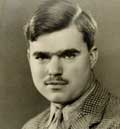 Lance Corporal John Pennington Harman VC - The Queen's Own Royal West Kent's, Kohima, 1944
Lance Corporal John Pennington Harman VC - The Queen's Own Royal West Kent's, Kohima, 1944
Born: 20 July 1914, Beckenham, London. Died: 9 April 1944 aged 30
At Kohima, Assam, on 8th April 1944, Lance Corporal Harman was commanding a section of a forward platoon. The enemy had established a machine-gun post within 50 yards of his position which became a serious menace to the remainder of his company. Unable to bring the fire of his section on to the post, Lance Corporal Harman went forward by himself and annihilated the post, returning with the enemy machine-gun. The next morning, having first recovered a forward position, he again charged an enemy post alone, shooting four and bayonetting one, thereby wiping out the post. As he returned Lance Corporal Harman received an burst of machine-gun fire in his side and died shortly after reaching our lines. Lance Corporal Harman's heroic action and supreme devotion to duty were largely responsible for the decisive way in which all attacks were driven off by his company.
The following additional VC's were won by officers serving away from their regiments:
New Zealand, 1864
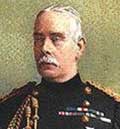 Lieutenant Colonel John Carstairs McNeill VC, 107th of foot
Lieutenant Colonel John Carstairs McNeill VC, 107th of foot
Born: 28 March 1831, Argylshire, Scotland. Died: 25 May 1904 aged 73
Private Vosper states that he was sent on that day with Private Gibson, of the same Force, as an escort to Major (now Lieutenant- Colonel) McNeill, Aide-de-Camp to Lieutenant-General Sir Duncan Cameron. Lieutenant-Colonel McNeill was proceeding to Te Awamutu on duty at the time. On returning from that place, and about a mile on this side of Ohanpu, this Officer, having seen a body of the enemy in front, sent Private Gibson back to bring up Infantry from Ohanpu, and he and Private Vosper proceeded leisurely to the top of a rise to watch the enemy.
Suddenly they were attacked by about 50 natives, who were concealed in the fern close at hand. Their only chance of escape was by riding for their lives, and as they turned to gallop, Private Vesper's horse fell and threw him. The natives thereupon rushed forward to seize him, but Lieutenant-Colonel McNeill, on perceiving that Private Vosper was not following him, returned, caught his horse, and helped him to mount. The natives were firing sharply at them, and were so near that, according to Private Vesper's statement, it was only by galloping as hard as they could that they escaped. He says that he owes his life entirely to Lieutenant-Colonel McNeill's assistance, for he could not have caught his horse alone, and in a few minutes must have been killed.
West Africa, 1903
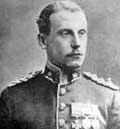 Lieutenant Wallace Duffield Wright VC - The Royal West Surrey's (Queen's)
Lieutenant Wallace Duffield Wright VC - The Royal West Surrey's (Queen's)
Born: 20 September 1875, Gibraltar. Died: 25 Mar 1953
On 24th March, 1903 (in northern Nigeria), Lieutenant Wright with only one officer and forty-four men took up a position in the path of the advancing enemy, and sustained the determined charges of 1,000 horse and 2,000 foot for two hours, and when the enemy, after heavy losses, fell back in good order, Lieutenant Wright continued to follow them till they were in full retreat. The personal example of this officer, as well as his skillful leadership, contributed largely to the brilliant success of this affair. He in no way infringed his orders by his daring initiative, as, though warned of the possibility of meeting large bodies of the enemy, he had purposely been left a free hand.
First World War
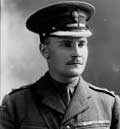 Lieutenant Colonel Bernard Cyril Freyberg VC DSO - Royal West Surrey's (Queen's) The Somme
Lieutenant Colonel Bernard Cyril Freyberg VC DSO - Royal West Surrey's (Queen's) The Somme
Born: 21 March 1889 Richmond, Surrey. Died: 4 July 1963 aged 74
By his splendid personal gallantry he carried the initial attack straight through the enemy's front system of trenches. Owing to mist and heavy fire of all descriptions, Lieutenant-Colonel Freyberg's command was much disorganised after the capture of the first objective. He personally rallied and re-formed his men, including men from other units who had become intermixed. He inspired all with his own contempt of danger. At the appointed time he led his men- to the successful assault of the second objective — many prisoners being captured. During this advance he was twice wounded. He again rallied and re-formed all who were with him, and although unsupported in a very advanced position, he held' his ground for the remainder of the day, and throughout the night, under heavy artillery and machine gun fire. When reinforced on the following morning, he organised the attack on a strongly fortified village and showed a fine example of dash in personally leading the assault, capturing the village and five hundred prisoners. In this operation he was again wounded. Later in the afternoon, he was again wounded severely, but refused to leave the line till he had issued final instructions. The personality, valour and utter contempt of danger on the part of this single Officer enabled the lodgment in the most advanced objective of the Corps to be permanently held, and on this point d'appui the line was eventually formed.
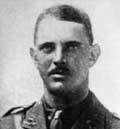 Captain Clement Robertson VC - Royal West Surrey's (Queen's) Belgium. Attached to A Battalion, Tank Corps
Captain Clement Robertson VC - Royal West Surrey's (Queen's) Belgium. Attached to A Battalion, Tank Corps
Born: 15 December 1890. Pietermaritzburg, S.A. Died: 4 October 1917 aged 27
On 4 October 1917 at Zonnebeke, Belgium, Captain Robertson led his tanks in attack under heavy shell, machine-gun and rifle fire over ground which had been ploughed by shell-fire. He and his batman had spent the previous three days and nights going back and forth over the ground, reconnoitering and taping routes, and, knowing the risk of the tanks missing the way, he now led them on foot, guiding them carefully towards their objective, although he must have known that this action would almost certainly cost him his life. He was killed after the objective had been reached, but his
skillful leading had already ensured success.
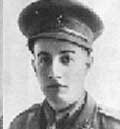 Lieutenant Cecil Harold Sewell VC - The Queen's Own Royal West Kent
Lieutenant Cecil Harold Sewell VC - The Queen's Own Royal West Kent
Born: 27 January 1895, Greenwich, London. Died: 29 August 1918 aged 23
Buried Vaulx Hill Cemetery, Vaulx-Vraucourt
On 29 August 1918 at Fremicourt, France, Lieutenant Sewell, who was in command of a section of Whippet light tanks, got out of his own tank and crossed open ground under heavy machine-gun fire to rescue the crew of another Whippet of his section which had side-slipped into a shell-hole, overturned and caught fire. The door of the tank had become jammed against the side of the shell-hole, but Lieutenant Sewell, unaided, dug away the entrance to the door and released the crew. Having done this, he saw one of his own crew lying wounded behind his tank. He crossed the open ground to go to his assistance. Although hit while doing so, he reached the tank. Only few minutes later he was hit, fatally this time, while dressing his wounded driver
Second World War
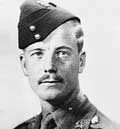 Lieutenant Alec George Horwood VC DCM - Royal West Surrey's (Queen's)
Lieutenant Alec George Horwood VC DCM - Royal West Surrey's (Queen's)
Born: 6 January 1914, Deptford, London. Died: 20 January 1944, Burma
On 18 January 1944 at Kyauchaw, Burma (now Myanmar), Lieutenant Horwood accompanied a company into action with his forward mortar observation post. Throughout the day he was in an exposed position and under intense fire, but he came back at night with most valuable information about the enemy. On 19 January he moved forward and established another observation post, directing accurate mortar fire in support of two attacks, and also carrying out personal reconnaissance, deliberately drawing the enemy fire so that their position could be definitely located. On 20 January he volunteered to lead the attack and while doing so was mortally wounded.
(No known grave - commemorated on the Rangoon Memorial.)
VC held by the Lord Ashcroft Collection, I.W.M.
 Captain Eric Charles Twelves Wilson VC- East Surrey Regiment
Captain Eric Charles Twelves Wilson VC- East Surrey Regiment
Born: 2 October 1912, Sandown, Isle of Wight. Died: 23 December 2008 aged 96
In August 1940, Wilson was 27 years old, and by then an acting captain attached to the Somaliland Camel Corps, when Italian forces commanded by General Guglielmo Nasi invaded British Somaliland (now part of Somalia). During the Italian conquest of British Somaliland the heavily outnumbered British-led forces made their stand on the hills around Tug Argan. During this battle, from 11 August to 15 August 1940 at Observation Hill, Captain Wilson kept a Vickers machine-gun post in action in spite of being wounded and suffering from malaria.
Some of his guns were blown to pieces by the enemy's field artillery fire, and his spectacles were smashed. He was wounded in the right shoulder and the left eye, and he was assumed to have been killed.
Wilson has the rare distinction of being mistakenly awarded a "posthumous" VC, announced in The London Gazette on 16 October 1940. At the time the award was made, he was believed to be missing in action, presumed dead. He had, however, been captured by the Italians. In 1941, when the Italian forces in East Africa surrendered following the East African Campaign, Wilson was released from captivity. He returned to England and received his Victoria Cross at Buckingham Palace in July 1942.
VC held by The Lord Ashcroft Collection, I.W.M.
Formerly served with Forebear Regiments - WWII
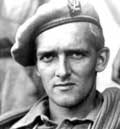 Major Anders Frederik Emil Victor Schau Lassen VC MC - Formerly Buffs, later SBS
Major Anders Frederik Emil Victor Schau Lassen VC MC - Formerly Buffs, later SBS
Born: 22 September 1920, Copenhagen. Died: 9 April 1945 aged 24
A Danish born Major, he emigrated to England at the start of WW2. He joined the British Army in 1940 as a private in The Buffs. Killed in action on 9th of April 1945 in Commachio, Italy, while single handed attacking and destroying three German pillboxes. He was posthumously awarded the Victoria Cross as the only non-British Empire soldier in World War 2. During his service he fought in North Africa as member of the Small Scale Raiding Force, in The Aegaean Sea and Italy as member of D Squadron 1st Special Air Service Regiment as a part of The Special Boat Squadron.
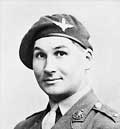 Captain Lionel Ernest Queripel VC - Formerly Royal Sussex, later SAS, Arnhem
Captain Lionel Ernest Queripel VC - Formerly Royal Sussex, later SAS, Arnhem
13 July 1920, Winterborne Monkton, Dorset. Died: 19 September 1944 aged 24
By 1400 hrs on 19th of September the confusion and heavy casualties saw Captain Queripel acting as commander of a company composed of the men of three parachute battalions. As they advanced along a main road on an embankment towards Arnhem they came under continuous machine-gun fire. At one point, the fire became so heavy that the company was split up on either side of the road and suffered considerable losses. Captain Queripel immediately began to reorganise his troops, crossing and recrossing the road while doing so, under extremely heavy and accurate fire from a strong point consisting of a captured British anti-tank gun and two machine guns. Whilst carrying a wounded sergeant to the regimental aid post under fire he was himself wounded in the face.
Having reorganised his force, Captain Queripel personally led a party of men against the strong point holding up the advance. Despite the extremely heavy fire directed at him, Captain Queripel succeeded in killing the crews of the machine-guns and recapturing the anti-tank gun enabling the advance to continue. Later Captain Queripel was ordered to defend some woodland near the Wolfheze level crossing which was vital to the allied advance (Wolfheze is about 12km to the northwest of Arnhem Bridge but only a few hundred metres from the Drop and Landing Zones used).
By this time he had received further wounds in both arms, was cut off with a small party of men and took up a position in a ditch. Disregarding his injuries and the heavy mortar and machine gun fire, he continued to inspire his men to resist with hand grenades, pistols, and the few remaining rifles. On at least one occasion he picked up and threw back an enemy stick grenade which had landed in the ditch. As the enemy pressure increased, Captain Queripel decided that it was impossible to hold the position any longer and ordered the men to withdraw. Despite their protests, he insisted on remaining behind to cover their withdrawal with his automatic pistol and a few remaining hand grenades. This was the last occasion on which he was seen.
Lt. G R P Roupell
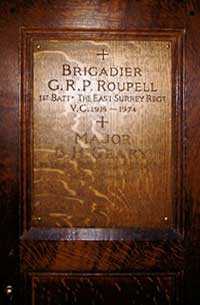
Memorial
Lt. G R P Roupell
Guildford Crematorium, Godalming, Surrey
Lance Corporal L J Keyworth
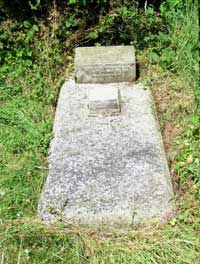
The burial place of
Lance Corporal L J Keyworth
Abbeville Communal Cemetery, Somme, France
Sergeant Harry Wells VC
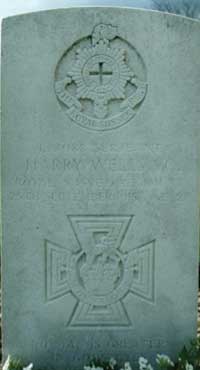
The burial place of
Sergeant Harry Wells VC
Le Rutoire, Loos, France
Lieutenant E A McNair VC
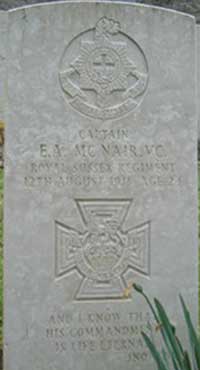
The burial place of
Lieutenant E A McNair VC
Staglieno War Cemetery, Genoa, Italy
Corporal W Cotter VC
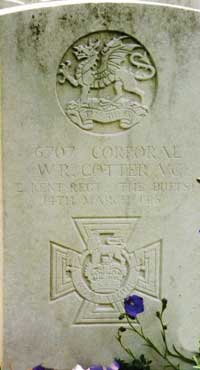
The burial place of
Corporal W Cotter VC
Royal Irish Rifles Churchyard, Laventie, France
CSM N V Carter VC
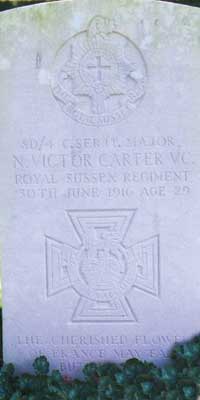
The burial place of
CSM N V Carter VC
Lillers Communal Cemetery, France
2nd Lt R P Hallowes
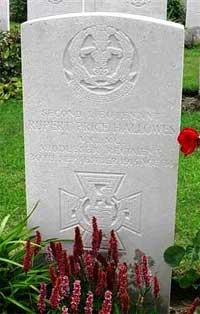
The burial place of
2nd Lt R P Hallowes
Bedford House Cemetery
Zillebeke, Near Ypres
Lt-Col AD Borton VC

The burial place of
Lt-Col AD Borton VC
St Mary's Churchyard, Hunton, Near Maidstone, Kent
Cpt AMC McReady-Diarmid
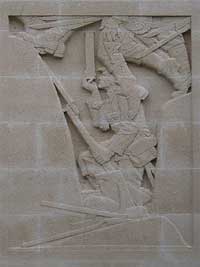
Commemoration
Cpt AMC McReady-Diarmid
(Missing in Action)
Cambrai Memorial
Near Doignes, France
Lance Corporal J W Sayer VC
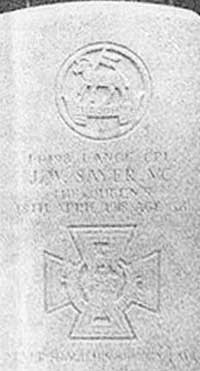
The burial place of
L/ Cpl J W Sayer VC
Le Cateau Cemetery, France
Lt. Col. C Bushell VC
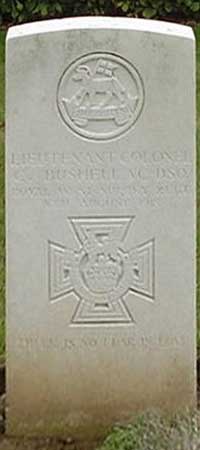
The burial place of
Lt. Col. C Bushell VC
Querrieu British Cemetery, Somme
Sergeant T J Harris VC
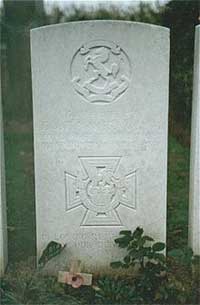
The burial place of
Sergeant T J Harris
Dernancourt Communal Cemetery Extension, Somme
Private Jack Harvey VC
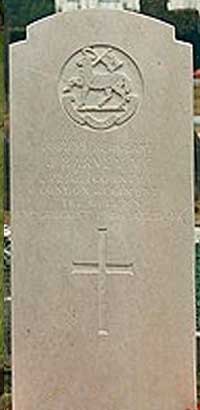
The burial place of
Private Jack Harvey VC
Redhill Cemetery, Surrey
2nd Lieutenant D J Dean VC
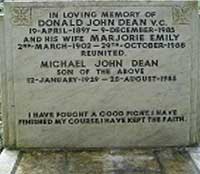
The burial place of
2nd Lieutenant D J Dean VC
St John the Baptist Churchyard, Tunstall, Kent
Lt. Col. D G Johnson VC
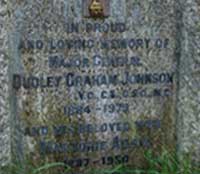
The burial place of
Lt. Col. D G Johnson VC
Christ Church, Church Crookham, Hampshire
Lt. C H Sewell VC
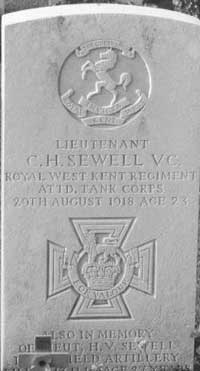
The burial place of
Lt. C H Sewell VC
Vaulx Hill Cemetery, Vaulx-Vraucourt.
Arras France
Sevastapol Cannon
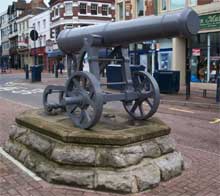
Maidstone
Drummer D Stagpoole VC
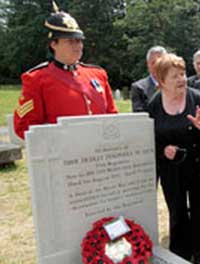
The burial place of
Drummer D Stagpoole VC
Hendon Cemetery
"Victoria Cross hero, honoured with restored grave...
Alec George Horwood VC
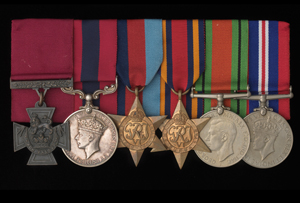
 Victoria Cross Awards Queen's Forebear Regiments
Victoria Cross Awards Queen's Forebear Regiments